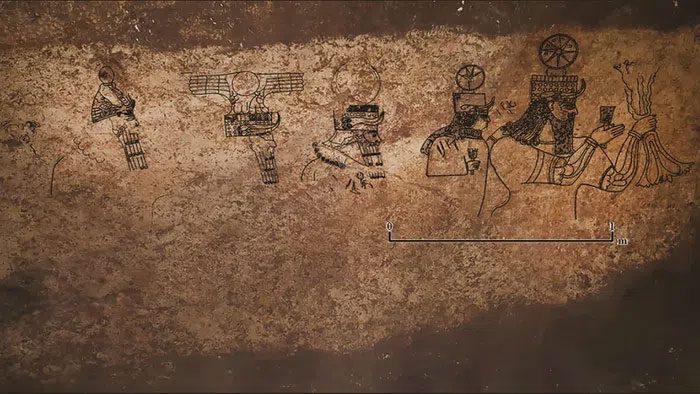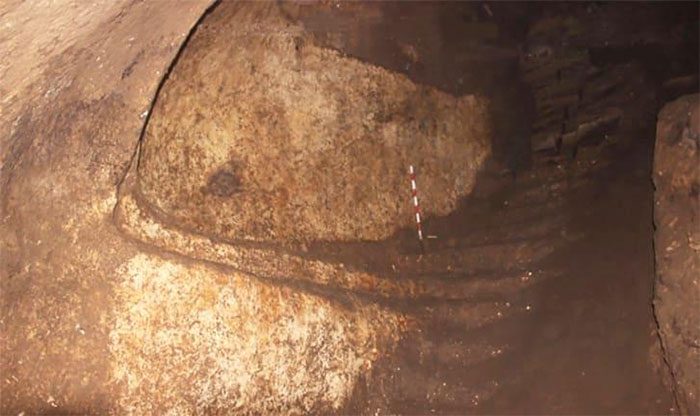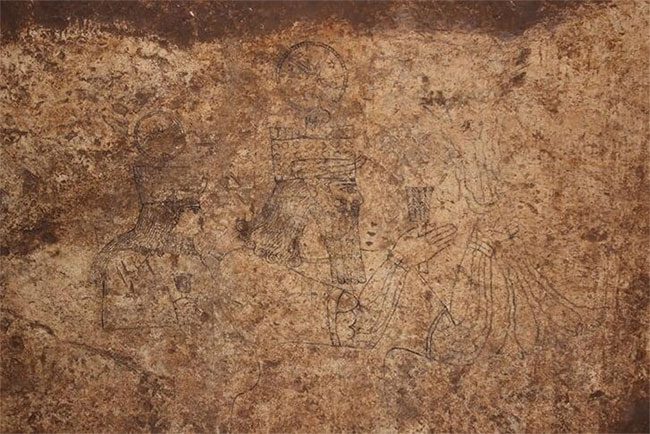A surprising discovery has revealed that an ancient artwork was once part of an Iron Age complex beneath a house in southeastern Turkey. This unfinished structure depicts a divine procession and illustrates the interaction of various cultures.
Initially, in 2017, thieves broke into the underground complex by drilling a hole in the ground floor of a two-story house in Başbük village. The drilled hole reached the limestone bedrock, approximately 30 meters below the house.
When the thieves were apprehended by authorities, in 2018, a team of archaeologists conducted a rescue excavation of the underground complex before it could erode further in the fall, aiming to study the significance of the area and the artwork on the stone. The findings were shared in a study published on Tuesday by the journal Antiquity.
The artwork dates back to the 9th century BCE during the Neo-Assyrian Empire, which originated in Mesopotamia and gradually expanded to become the largest superpower of its time. Between 600 and 900 BCE, it extended into Anatolia—a large peninsula in Western Asia that includes much of present-day Turkey.


Archaeologists followed a long stone staircase to an underground room where they found rare artworks on the walls. (Source: C. Uludağ)
Research author Selim Ferruh Adali, an associate professor of history at Ankara Social Sciences University in Turkey, stated: “When the Assyrian Empire exerted political power in Southeast Anatolia, the Assyrian governors expressed their authority through art in the Assyrian court style.” The authors noted that a typical example of this style is the carving of grand stone reliefs, but examples from the Neo-Assyrian Empire are quite rare.
Integration of Cultures
The artwork showcases cultural integration rather than complete conquest. The names of the gods are inscribed in the local Aramaic language. Symbols representing religious themes from Syria and Anatolia were created in the Assyrian style.
Adali mentioned: “It shows that during the early period of Neo-Assyrian rule, there was coexistence between the Assyrians and the Arameans in the same region.” He added, “Başbük village provides scholars studying the nature of empires with a prominent example of regional tradition, ways to maintain voice, and importantly, the exercise of imperial power as expressed through sculptural art.”
Adali shared: “The artworks depict eight gods that are still unfinished. The largest figure stands 1.1 meters tall. The local gods represented in the artwork include: the Moon God Sîn, the Storm God Hadad, and the Goddess Atargatis. Behind them, researchers identified a Sun God and other deities. The inscriptions combine symbols of Syro-Anatolian religion with representative elements of Assyria.”

Part of the artwork featuring the Storm God Hadad and Atargatis – the goddess of northern Syria. (Source: M. Önal)
Adali remarked: “Incorporating Syro-Anatolian religious themes to illustrate Neo-Assyrian characteristics in a way that was unexpected from previous findings. They reflect an earlier stage of the Assyrian presence in the region when the local environment was more prominently highlighted.”
Upon discovering this artwork, research author Mehmet Önal, a professor of archaeology at Harran University in Turkey, stated: “When the dim light of the lamp illuminated the figures of the gods, I shivered with fear as I realized I was facing the expressive eyes and majestic face of the Storm God Hadad.”
Unresolved Mysteries
The research team also identified an inscription that may indicate the name of Mukīn-abūa—a Neo-Assyrian official who served during the reign of Adad-nirari III from 783 to 811 BCE. Archaeologists suspect that he may have been assigned to this area at that time and was using the complex as a means to rally the local populace.
However, the unfinished structure and its incomplete state during this time suggest that something caused the builders and artists to abandon it, possibly even a rebellion.
Adali noted: “The work was carried out by local artists serving the Assyrian administration, who adapted Neo-Assyrian art to the provincial management context. It was used to conduct ceremonies overseen by the provincial authorities. It may have been abandoned due to changes in provincial governance and practices or due to arising political-military conflicts.”
Adali is a researcher of inscriptions who read and translated the Aramaic engravings in 2019 using photographs taken by the research team, who had to work swiftly to study the site.
Adali remarked: “I was shocked to see the Aramaic inscriptions on such artworks; a tremendous sense of excitement filled me as I read the names of the gods.”
The complex was closed after the 2018 excavation because it was no longer stable and was at risk of collapse. It is now under the legal protection of the Turkish Ministry of Culture and Tourism. Archaeologists are eager to continue their work if excavations can be safely conducted again. They hope to capture new images of the artwork and inscriptions, as well as potentially discover more artworks and artifacts.





















































